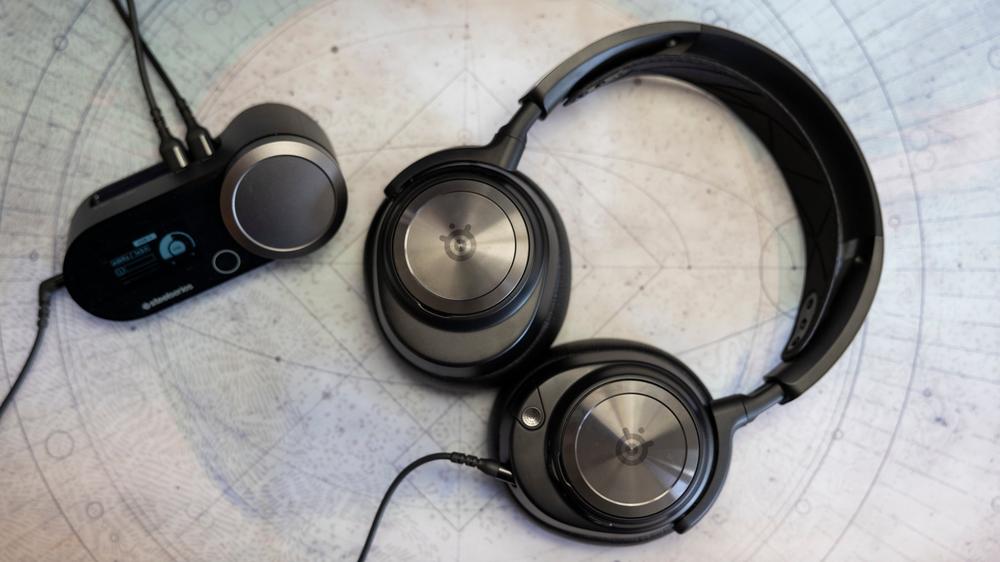If you’re reading this, you already know the importance of good audio when it comes to gaming, but it’s tough to find out which is the best gaming headset for you among the sea of options. As is the case when you're looking for the best gaming mouse or best gaming keyboard, there are several factors to consider. When looking for the right headset, you'll want to account for your budget and seek out the best sound quality and comfort, as well as the kinds of features most important to you. The easiest way to find that personalized experience is to know exactly what you’re getting into and rely on those who have first-hand knowledge.
I’ve reviewed plenty of headphones and gaming headsets in my time, so I’m familiar with what makes them great, and I’ve put my expertise and ears-on experience to use here. Each pick was made with careful consideration for what each headset offers as a whole, but also for the aspects they excel in most based on their category. With that in mind, I’ve included options for the best budget headset like the HyperX Cloud III and the best high-end option in the Audeze Maxwell, for example. But more sophisticated features like virtual surround, active noise cancelation, or customizable EQ profiles can be defining for certain wireless headsets like the Razer Kraken V4, Alienware Pro, or Logitech G Pro X 2.
TL;DR: These Are the Best Gaming Headsets:
This guide is intended to be a comprehensive look at the best options based on specific categories in which certain headsets prioritize or do better than the competition. This doesn’t mean there aren’t amazing headsets outside of the ones I’m recommending, but these are all headsets I can vouch for based upon the first-hand testing done by me and my colleagues. These are also great options whether you play games on PC, PS5, Xbox, Switch 2, or any mix of consoles (just be sure to get the right model when picking something out). I will also be updating my picks as new ones come out and I test more of what’s out there, so be sure to check back periodically, or whenever you need some advice on choosing a new gaming headset.
This guide contains contributions by Danielle Abraham and Adam Matthew.
Best Gaming Headset
Best Budget Gaming Headset
Best High-End Gaming Headset
Best Wireless Gaming Headset
Best Budget Wireless Gaming Headset
Best Wired Gaming Headset
Best Audiophile Gaming Headset/Headphones
Best Surround Sound Gaming Headset
Best Esports Gaming Headset
Best Noise-Cancelling Gaming Headset
Best Gaming Earbuds
First thing’s first: How much are you willing to spend? Next thing to ask yourself is, what are your biggest priorities when looking for a gaming headset? Is it overall sound quality, comfort, microphone clarity, durability, or something else? And if you want to go wireless, you have to consider battery life and what a headset’s software suite is capable of. You’ll likely want some mix of all those things, but while you don’t have to pick one particular feature or strength to seek out among a wide array of options, some headsets simply do certain things better than others.
For me, sound quality is the primary factor to look for regardless of price range (it’s rather a matter of managing expectations with more budget-friendly options). While the size of the drivers – the actual hardware in each earcup that produces sound – is an easy shorthand for determining a headset’s potential, it’s certainly not the be-all-end-all. How the headset is tuned, the material and physical construction of the drivers, and how it sounds in specific scenarios are things you can only learn about through reviews and first-hand accounts, if you can’t test it for yourself. Pay attention to what reviewers say about frequencies like bass/lows, mids, and highs and the ways they describe their experience. Sometimes bass drowns out other frequencies, mids might be distorted in hectic gameplay, or the highs are harsh at loud volumes – these are the types of things we say when describing audio shortcomings. Some folks like deep bass even if it’s overpowering, so some detractors may not matter as much to some, for example.
Positional or spatial audio is also crucial for competitive gamers. The best headsets are able to express the details and nuances of sound effects, not just produce clear frequencies. This helps you judge direction and distance of footsteps or gunshots in games like Counter-Strike 2 and Valorant, for example, and can also result in a more immersive experience in single-player games or even movies. Some of this can be simulated through software but things like Turtle Beach’s Superhuman Hearing tend to sound too artificial, so be wary.
Comfort is another thing that can be challenging to understand without trying on a headset first. However, you can pay attention to descriptors such as clamp force (how hard a headset latches onto one’s head), the density of the earpads, the type of material used to wrap the earpads, or how the headband rests above the user’s head. Materials like leatherette, sports mesh, and velour all have their pros and cons with the former being better for sound isolation but not as great as the latter for airflow and mitigating sweat around the ears.
When it comes to durability, many premium-level headsets use an aluminum frame, which may be heavier but can withstand much more contortion and mishandling. Some budget-friendly headsets opt for a flexible rubber-like plastic headband that offers a similar level of flexibility, so it doesn’t feel like you’re going to break the thing when putting it on or taking it off. Any gaming headset worth its salt shouldn’t have durability issues, but it is something to consider.
I typically find the built-in microphones on gaming headsets to be an afterthought, mainly because you can get much better sound quality from a standalone external microphone – that’s what I use most of the time. But that doesn’t mean I overlook microphone clarity altogether. It’s rare to find a headset outside of the premium price range with a great mic, but it’s something we as reviewers always test because it’s certainly nice to have. Something like the HyperX Cloud III was truly impressive for a mic on a $100 gaming headset, and the Beyerdynamic MMX 300 Pro is close to approaching mid-range standalone mics – and those who often use voice for communication or some sort of content creation can get a lot out of a good headset mic. Noise isolation is worth paying attention to, as well as how well it picks up your voice – software-side features like controlling the noise gate can also be useful. And don’t overlook the importance of sidetone, which is a rare feature that automatically feeds your voice back to you.
Wireless gaming headsets have evolved to the point where battery life is either a non-issue or manageable with good habits of charging them whenever you can. But for headsets you’re planning on using for multiple purposes (like ones with simultaneous Bluetooth connectivity for music on mobile devices, for example), total battery life can be a more important factor. Many should last in the 40-hour range from a full charge and higher-end ones can last upwards of 80 hours, although several variables feed into how long they last in actuality.
The last thing I’ll mention is customizability, at least through software. Every gaming peripheral manufacturer has its own software suite it wants you to download, and they tend to be all-encompassing apps for all its gaming gear. But good software lets you get granular with your headset, such as Turtle Beach’s Swarm app. You can fiddle with equalization, make your own EQ presets, use premade profiles, control certain aspects of your microphone, and so much more. While it’s not as important as the essentials like sound quality and comfort, a proper software suite can help you get the most out of your purchase.
How do you determine sound quality on a gaming headset?
There are ways to extract audio data from a headset to get a look at how they handle various frequencies, like artificial ear and audio analyzing software, but that alone won’t be able to tell you what the actual audio experience is like. Admittedly, it can be quite abstract to have someone describe what games, music, or movies sound like. Paying attention to descriptors like distortion, drowning, cleanliness, or balance when talking about frequencies are common ways to explain the sound quality of a device, and at some point you need to trust the reviewer’s trained ear.
There’s also the factor of driver size, the actual hardware that delivers the audio. Generally, bigger drivers means better potential for cleaner and bolder sound, but again, that alone isn’t going to determine whether or not a headset sounds good. Quality can also come down to spatial or positional audio which gives the impression of sound effects having distance and direction – it’s important for competitive settings but can make for more immersive experiences outside of trying to get an advantage over your opponents.
What makes gaming headsets different from headphones?
Gaming headsets tend to pack additional features that support the actual gaming experience, some of which may be gimmicky, but many that I would call essential. Not everyone wants to have a standalone microphone, for example, but the key feature that separates a headset from headphones, is a built-in microphone. While most headset mics are passable in terms of clarity that can suffice for in-game communication, some go the extra mile to provide better clarity or mitigate ambient noise spilling through.
Good gaming headsets are generally tuned to pick up on certain sound effects and have a more intimate sound profile since you’re an active participant in the experience rather than a passive observer (especially in competitive games). When it comes to wireless capabilities, most gaming headsets come with 2.4GHz USB dongles for the lowest latency possible – something that wireless headphones rarely include. As you’ll see in the next section, software suites for USB-based headsets (wireless or otherwise) have gotten sophisticated as well and sometimes offer a level of customization for specific gaming scenarios.
Should I go wired or wireless for a gaming headset?
Of course, it depends on your needs. I still gravitate towards wired headsets and headphones since I tend to prefer the sound profiles of a properly-tuned analog audio device (I also tend to forget about charging devices until it’s too late, but that’s a me-problem). However, battery life and latency of modern gaming headsets have come so far that you rarely, if ever, see them being issues on the latest releases. Good software suites and apps can also help you get more out of your headset by letting you customize EQ settings or swap sound profiles for certain games.
Wireless headsets are also sometimes capable of multi-device connectivity and simultaneous Bluetooth, which makes them versatile and opens them up to more use-cases (especially swapping to a mobile connection within seconds). Even though they tend to be more expensive, there’s a lot of upside to going with a wireless gaming headset, just be sure you know what you’ll be getting out of it.
Is virtual surround sound worth seeking out?
Virtual surround sound had been a bit of a gimmick when high-end headphones started simulating the experience of a 7.1 speaker setup. But I will admit that the technology has come a long way. It’s not always best suited for gaming, especially in the competitive scene – there’s some artificiality with virtual surround that can lead to misjudging audio cues. But damn does something like DTS Headphone:X or Dolby Atmos sound impressive when done right – especially in action games or movies.
Some virtual surround sound software requires you to purchase a license, and personally I find the overall applicability of them fairly niche, but that doesn’t take away from how they simulate theater-like qualities. Just because a headset is compatible with features like Dolby Atmos or DTS Headphone:X, it doesn’t mean you’ll get an equal virtual surround experience – the headset itself has to be equipped to express a level of nuance in its sound quality for it to work well.

 After raising over $3M, popular VC-backed beauty brand Ami Colé is shuttering
After raising over $3M, popular VC-backed beauty brand Ami Colé is shuttering